Click on images to enlarge
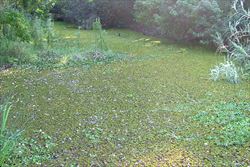
dense infestation (Photo: Sheldon Navie)

dense infestation (Photo: Sheldon Navie)

dense infestation (Photo: Sheldon Navie)
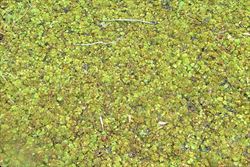
habit (Photo: Sheldon Navie)

habit (Photo: Sheldon Navie)
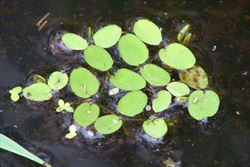
primary growth form with flattened 'leaves' (Photo: Sheldon Navie)
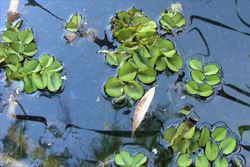
secondary growth form with folded 'leaves' (Photo: Sheldon Navie)
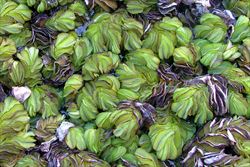
tertiary growth form with very folded and densely clustered 'leaves' (Photo: Sheldon Navie)
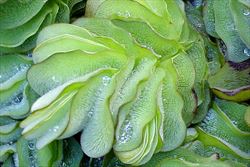
'leaves' (Photo: Sheldon Navie)
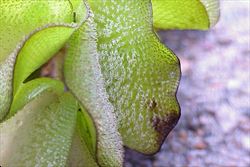
close-up of 'leaves' showing egg-beater shaped hairs (Photo: Sheldon Navie)
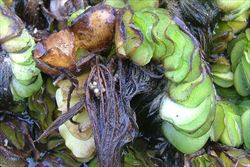
'roots' and sterile spore sacs (Photo: Sheldon Navie)
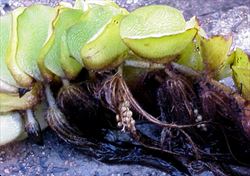
close-up of leaves, stems, 'roots' and sterile spore sacs (Photo: Sheldon Navie)
Scientific Name
Salvinia molesta D.S. Mitchell
Synonyms
Salvinia auriculata Aubl. (misapplied)Salvinia cucullata Bory (misapplied)
Family
Salviniaceae
Common Names
African payal, African pyle, aquarium water moss, aquarium water-moss, giant salvinia, giant water fern, kariba weed, kariba-weed, karibaweed, salvinia, water fern
Origin
Native to South America (i.e. south-eastern Brazil).
Cultivation
This species was introduced for the aquarium industry and is also commonly found in garden ponds and water features.
Naturalised Distribution
This species is mainly distributed along the eastern coast of Australia, from central New South Wales through to northern Queensland. Scattered infestations are also often found in the Northern Territory and Western Australia, and less often in Victoria and South Australia. Also recently recorded on Norfolk Island.
It has also become a serious weed throughout Africa, the Indian Sub-continent (i.e. India and Sri Lanka), south-eastern Asia (e.g. the Philippines and Papua New Guinea), New Zealand, several Pacific islands (e.g. Fiji and Hawaii) and southern USA (i.e. California, Arizona, Texas, Louisiana, Mississippi, Alabama, Georgia, Florida, South Carolina and North Carolina).
Habitat
A serious problem in rivers, streams, lakes, dams, swamps, irrigation channels, drainage lines and other bodies of water and is also a pest of rice crops around the world. Mainly a weed of tropical, sub-tropical and warmer temperate regions, though it will grow on waterbodies in semi-arid areas.
Habit
A free-floating freshwater (i.e. aquatic) fern with branching horizontal stems and submerged feathery ‘roots'. Its stems break apart readily and it can quickly form dense mats of foliage on the water surface. Younger plants generally have smaller, flat, 'leaves' that are more spread apart (i.e. the primary growth form). As the plants get older, larger 'leaves' are produced that are slightly folded and borne closer together along the stems (i.e. the secondary growth form). Eventually the 'leaves' become very folded in nature and are compactly arranged along the stems (i.e. the tertiary growth form).
Distinguishing Features
- a free-floating freshwater plant forming dense mats of vegetation on the water surface.
- its folded ‘leaves’ are borne in pairs and emerge above the water surface.
- it has submerged 'roots' that are highly divided and feathery in appearance.
- its 'leaves' have a covering of egg-beater shaped hairs (about 1 mm long) on their upper surface.
- sterile spore sacs are often present among the submerged 'roots'.
Stems and Leaves
Individual plants (i.e. ramets) can consist of as little as a piece of stem with two floating 'leaves' (i.e. fronds) and a third 'leaf', which is modified into feathery 'roots' and remains submerged. Plants produce slender, branching runners and form mats of vegetation very quickly. These slender stems (1-2 mm thick) are much-branched and grow up to 30 cm long (usually only 6-25 cm long) before separating to form new plants. The length of stem between the joints (i.e. nodes), that is the internode length, varies depending on the density of the weed. When plant density is low the 'internode' length is relatively long, but as plant density increases, the 'internode' length may become very short.
The 'leaves' (i.e. fronds) are oval or folded, borne on short stalks (i.e. petioles), and are green or yellowish-green in colour. These 'leaves' (20-60 mm long and 10-15 mm wide) have a covering of water-repellent waxy hairs (i.e. papillae) on their upper surface. These hairs (1-3 mm long) are arranged in distinct rows and are tipped with distinctive egg-beater shaped structures that aid buoyancy. The undersides of the leaves are covered in densely matted brown hairs. The 'roots' (i.e. submerged fronds) are brown in colour and highly divided into many filaments (2-50 cm long).
Flowers and Fruit
Flowers are not produced by this species, instead sterile spore sacs (i.e. sporocarps) form along the filaments of the submerged root-like fronds. These small rounded (i.e. globular) spore sacs (1-3 mm across) are covered in hairs (i.e. they are pubescent) and borne in elongated clusters that dangle below the water surface.
Reproduction and Dispersal
This plant reproduces vegetatively, with the floating branches readily breaking apart and forming new plants.
Dispersal of these plants occurs during floods and also during water movement caused by water currents or wind. It is most commonly spread to new areas by the dumping of aquatic garden waste, but may also be spread by animals, vehicles and boats.
Environmental Impact
Salvinia (Salvinia molesta ) is one of the Weeds of National Significance (WoNS) because of its invasiveness, potential for spread, and environmental impacts. It grows rapidly can can quickly cover the entire surface of waterbodies with a thick mat of vegetation, shading out any submerged plant life. Dense infestation can also impede oxygen exchange, making the water unsuitable for fish and other animals.
Salvinia (Salvinia molesta) is regarded as a significant environmental weed in Queensland and New South Wales, and as a potentialy significant environmental weed in the Northern Territory, Western Australia, the ACT, Victoria and South Australia. It is also very invasive in other parts of the world, and is listed in the Global Invasive Species Database (GISD).
Legislation
This species is declared under legislation in the following states and territories:
- ACT: C1 - notifiable pest plant (a pest plant whose presence must be notified), and C4 - prohibited pest plant (a pest plant whose propagation and supply is prohibited).
- New South Wales: Class 2 - a regionally prohibited weed. The presence of the weed must be notified to the local control authority and it must be eradicated from the land and the land must be kept free of the plant (in a majority of local authority areas), Class 3 - a regionally controlled weed. The relevant local control authority must be promptly notified of the presence of this weed and it must be fully and continuously suppressed and destroyed (in a minority of local authority areas). See the New South Wales Department of Primary Industries Noxious Weeds List at http://www.dpi.nsw.gov.au for more detailed information on which local areas are covered in these declarations.
- Northern Territory: B - growth and spread to be controlled (throughout the remainder of the Territory), and C - not to be introduced into the Territory. Salvinia cucullata and Salvinia natans are also declared C - not to be introduced into the Territory.
- Queensland: Class 2 - landowners must take all reasonable steps to keep land free of this species (throughout the entire state). It is also illegal to sell a declared plant or its seed in this state. All other salvinia species (i.e. Salvinia spp. other than Salvinia molesta) are also declared Class 1 - introduction into the state is prohibited, and landowners must take reasonable steps to keep land free of this species (throughout the entire state).
- South Australia: 1@ - this species is declared under Class 1a, a classification for prohibited aquatic plants. Its presence must be notified and the plant must be destroyed (throughout the entire state).
- Tasmania: D - the importation or sale of this species is prohibited and measures to reduce its population in an area, eradicate it from an area, or restrict it to a particular area may be required.
- Victoria: S - prohibited from the state and is to be eradicated if found.
- Western Australia: P1 - trade, sale or movement into the state prevented, and P2 - to be eradicated where found (throughout the entire state). All other salvinia species (i.e. Salvinia spp.) are on the prohibited species list (i.e. 'Prohibited') and not permitted entry into the state.
Management
For information on the management of this species see the following resources:
- the National Weeds Strategy Strategic Plan for salvinia (Salvinia molesta), which is available online at http://www.weeds.org.au/docs/salstrat.pdf.
- the Biosecurity Queensland Fact Sheet on this species, which is available online at http://www.dpi.qld.gov.au.
- the New South Wales Department of Primary Industries Agfact on this species, which is available online at http://www.dpi.nsw.gov.au.
- the Northern Territory Department of Natural Resources, Environment and The Arts Agnote on this species, which is available online at http://www.nt.gov.au/weeds.
- the Victorian Department of Sustainability and Environment Landcare Note on this species, which is available online at http://www.dse.vic.gov.au.
Similar Species
This a very distinctive floating plant and is rarely confused with other species. However it may appear similar to red azolla (Azolla filiculoides) and ferny azolla (Azolla pinnata) when young. The azollas (Azolla filiculoides and Azolla pinnata) can be distinguished from salvinia (Salvinia molesta) by having tiny overlapping scale-like leaves, not having egg-beater shaped hairs on the upper surface of their leaves, and by the fact that individual plants rarely grow larger than 2 cm in size.

